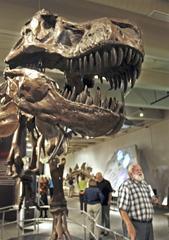About 65 million years ago, Jupiter and its anonymous teammate played a caustic game of pinball with an asteroid.
Jupiter acted first. It perturbed the asteroid’s orbit, hurdling the latter toward the second player, who then deflected it toward Earth.
The asteroid crossed Earth’s orbit, weaved its way through the Asteroid Belt and struck the Yucatan peninsula.
Ash usurped the sky, stealing sunlight from the earth.
That’s Dale Russell’s theory, anyway.
And the coordinator of the Dinosaur Research Center and visiting professor in marine, earth and atmospheric sciences said he risked his career and reputation within the scientific community to assert it.
All that’s left in the 21st century, he said, is a thin film of ash, some carbon and fossilized relics — a few of which now reside in the N.C. Museum of Natural Science’s exhibit, “Dinosaurs: Ancient Fossils, New Discoveries.” The exhibit is scheduled to visit five museums across the country. The impact triggered a substantial displacement of energy that elicited a series of tidal waves and searing ocean temperatures, among other effects.
“It was a catastrophe,” Russell said. “Plants became extinct. Dinosaurs utterly vanished.”
And now, some of those same towering animals that once reigned supreme — the Styracosaurus albertensis, Achelousaurus horneri and Centrosaurus apertus — exist only as skeletons, their heads hovering over groups of second-graders and dinosaur aficionados.
“Dinosaur skeletons are not common,” he said. “That’s why there’s a big to-do when you find a new dinosaur or new fossils.”
But this exhibit isn’t just a collection of bones. Every model, diorama and fossil highlights current research on dinosaurs, according to Betsy Bennett, director of the museum.
“Each specimen is here for telling a specific story on research,” she said.
And this research isn’t limited to facts and figures.
A robotic skeleton of a Tyrannosaurus rex walks in place to demonstrate how his real-life predecessors traveled. Its feet step gingerly onto black tile, its head nods up and down and its tail swings left to right.
A “thoroughly modern” steel Apatosaurus skeleton, its head looming over visitors, attempts to reach the ceiling.
Behind it, on three video screens, this same dinosaur morphs, muscle upon muscle, into a life-like portrait of its ancestor.
And this is only the beginning of the exhibit.
Toward the end, the exhibit delves into prehistoric feathered dinosaurs, underwater mammals, the three prevalent theories of extinction and the animals that survived.
This last point is imperative, according to Julia Clarke, research curator of paleontology and assistant professor of marine, earth and atmospheric sciences.
“Dinosaurs didn’t go extinct,” she said. “Not everything disappeared 65 million years ago. It’s neat to be able to bring [these facts] to those who still haven’t been able to see all the evidence that birds are living dinosaurs.”
For those who have yet to come across this knowledge, she said, all they need to do is look toward the sky.
But this species may not be flying among the clouds for much longer.
“Some people have argued that the second mass extinction of dinosaurs [birds] is right now,” she said, “and it’s human-induced.”
This is the first time the exhibit has visited the Southeast. Clarke said she hopes will enlighten both children and adults to the research on and discoveries about dinosaurs and the prehistoric world that existed millions of years ago.
“It’s fantastic that the museum is one of a very small number of major partner museums,” she said. “It really highlights the strength in paleontology at N.C. State, which is continuing to develop very well.”
These dinosaurs, she said, are the bridge to learning more about paleontology.
“Not only hearing about it in the classrooms or in the library, we’re bringing it to the public,” Clarke said. “We might, hopefully, be able to inspire the next generation of North Carolina paleontologists.”
And what might inspire this next generation — the models and animations —is developed and assembled using the same modern technology, such as computer programs and software, that are essential to other, more common professions, according to Vince Schneider, the museum’s curator of paleontology.
“You can see this model of how a dinosaur walks,” he said. “You can see how we’re using technology today to look at old fossils and bones and bring them back to life,” said Schneider.








